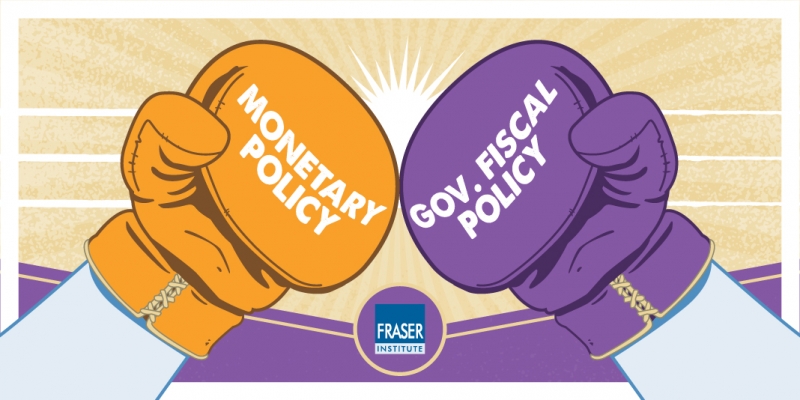Canada’s Fiscal Policy Has Undermined Efforts to Tackle Inflation

In response to the lockdown of large swathes of Canada’s economy when COVID began circulating in March 2020, both monetary and fiscal policy shifted to unprecedented stimulus. The Bank of Canada lowered interest rates to near zero and expanded its balance sheet over fourfold, while governments ran deficits exceeding those incurred during wartime. This extraordinary stimulus, along with the quick adaptation of businesses and individuals to social distancing and telework, helped the overall economy recover rapidly even as industries providing client facing services continue to struggle.
However, maintaining stimulus as much of the economy expanded beyond its pre-pandemic levels helped fuel inflation by boosting demand beyond supply. After a brief period of price declines in 2020, inflation began to pick up in the spring of 2021, accelerating to a 39-year high of 8.1 percent by July 2022. In response to higher inflation, the Bank of Canada began winding down its policy of quantitative easing and then hiked its policy interest rate sharply from 0.25 percent to 4.50 percent during 2022.
In the initial stages of the pandemic, the federal government hit a record $327.7 billion deficit in fiscal year 2020-21 and followed it up with deficits of $90.2 billion in 2021-22 and $43.0 billion in 2022-23. The deficits significantly exceeded those recorded before the pandemic began. According to former finance minister Bill Morneau, the federal government was “distributing billions of dollars more than was actually needed under the circumstances” during this time. Morneau revealed that the attitude of the Prime Minister’s Office (PMO) to spending requests was “let’s give something to keep them happy,” a stance he said “shattered any pretense of fiscal restraint.”
During the pandemic, government leaders consistently invoked low interest rates to rationalize their spending splurge and debt accumulation. The federal government, for instance, argued that “In today’s low interest rate environment, not only can we afford these investments in Canada’s future, it would be short-sighted of us not to make them.” The sudden end of low interest rates in 2022, however, did not curb governments’ enthusiasm for spending. Federal spending, for example, has remained at extraordinarily high levels even as COVID relief programs wound down in 2022. In fiscal year 2019-20, before the pandemic, federal program spending totalled $338.5 billion; in its 2023 budget, Ottawa projected program spending to be 28.9 percent above its 2019-20 level, reaching $435.9 billion in 2022-23.
Moreover, fiscal stimulus measures introduced before 2022 are still being felt by the economy, helping to boost inflation well above the forecasts of most economists and central banks at the start of 2022. The period during which a government deficit is recorded does not always correspond to when stimulus is injected into the economy. Much of the money governments transferred to households at the onset of COVID in 2020 was saved—as “pre-loaded stimulus,” in Finance Minister Chrystia Freeland’s own words—and was then spent in 2022 as inflation squeezed household purchasing power and normal economic activities resumed.
Without fiscal restraint, however, tight monetary policy alone will have difficulty returning inflation to its target rate. Monetary policy and fiscal policy must work together to reduce inflation.
In today’s high-inflation environment, tighter fiscal policy would dampen the increase in interest rates. Although the initial upturn of inflation has been driven largely by supply shocks in the economy (Chen and Tombe, 2022), it has also likely been fuelled in part by the large deficits posted during the pandemic. Without fiscal restraint, however, tight monetary policy alone will have difficulty returning inflation to its target rate. Monetary policy and fiscal policy must work together to reduce inflation. High government spending and deficits undermined the credibility of monetary policy in the 1960s and 1970s; acting together, tight money accompanied by fiscal restraint and regulatory reform combined to cure inflation in the early 1980s and prevented a resurgence in Canada in the early 1990s.
This paper draws on a growing literature that finds higher government spending and deficits helped fuel the recent surge of inflation and, therefore, that both monetary and fiscal policy need to be deployed to contain inflation. It is important that the federal government reverse the trend of substantially higher government spending and deficits that began in 2015 and accelerated after 2019. Although headline inflation has retreated from its peak, a return to its target rate will require fiscal policy to reinforce monetary policy restraint. Asking monetary policy alone to rein in inflation risks an outcome where inflation remains elevated while the economy stagnates. Persistent inflation would keep interest rates high and, together with slow growth, would put continued upward pressure on government deficits. The best way to avoid such an outcome is for Canada’s fiscal policy to align with monetary policy.
Author:
More from this study
Subscribe to the Fraser Institute
Get the latest news from the Fraser Institute on the latest research studies, news and events.


